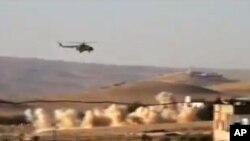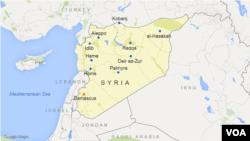A coalition of rebels who coordinate with the U.S. is fighting Islamic State (IS) in southern Syria to link two areas they hold, rebel leaders and U.S. officials told VOA.
Gaining the territory would enable rebels to box in IS fighters fleeing Raqqa and Mosul, take control of lucrative phosphate mines and potentially put pressure on Damascus in Syria’s civil war.
At stake is a strategic pocket in al-Qalmoun that is hemmed in by Syrian, IS and pro-Iranian forces. The rebels also hold the Syrian desert to the southeast that extends to the Jordanian border, so taking a chunk in between would help break a siege by IS.
Opening a supply route
Lieutenant Colonel Omar Semren, spokesman for a breakaway Syrian rebel battalion known as Forces of the Martyr Ahmed al-Abdo, told VOA that his forces, along with other Free Syrian Army (FSA) groups, would soon open a supply route that will link them with other U.S.-backed rebels.
“We will purify the area from IS, and break the siege that is applied on us by ISIS, [Syrian President Bashar al-]Assad and Iranian militia,” he said, using an acronym for the militant group.
IS is blocking a mountainous corridor that the rebels want, and it controls the biggest phosphate mines in the country to the north.
Syrian analyst Youseph Sadaki told VOA from Washington that the area’s lucrative natural resources are very important and that the Assad regime prefers IS to the rebels in that region.
“IS is protecting the phosphate mines, and the Syrian government signed an agreement with Russia and Iran to extract the phosphate,” Sadaki said. “The regime likes to see it in the hand of a weak organization like IS rather than moderate rebels that are accepted by the West. If the siege is going to be lifted, it will give a big boost to the anti-Assad, anti-IS trend in the area.”
Rebel groups
Eastern Qalmoun has a population of 600,000, many of them refugees from the suburbs of Damascus. The biggest rebel groups in the area are the Forces of the Martyr Ahmed al-Abdo, Jaish al-Islam, Faylak al-Ruhman, Ahrar al-Sham, and al-Qaida affiliate al-Nusra Front, also known as Fatah al-Sham.
Several of the groups receive assistance from a joint military center staffed by the U.S., Jordan and Saudi Arabia in Amman known as Military Operation Command, so the supply route would be able to get arms and food from Jordan to al-Qalmoun.
“Once we link the two regions, we will be in much better shape. Our fighters, along with other FSA groups, have cleared all the way to the Jordanian and Iraqi borders from IS,” Semren said. “We are building our safe zones with a limited support from our allies [the U.S-led coalition]."
The Forces of al-Abdo is part of the coalition and operates on both sides of the IS-held territory.
Aid from U.S.
The U.S. confirmed to VOA that it is helping rebel groups to varying degrees.
“The Vetted Syrian Opposition forces in the south conduct unilateral operations without coalition advice, assistance or accompany support,” said a statement from Operation Inherent Resolve. “They’re a capable fighting force who have shown the will, confidence and capacity to conduct unilateral operations in their pursuit of IS to liberate their home country.”
“We support channels of communication between our partnered forces frequently to ensure smooth operations,” the statement said. “The more than 60 nations and international organizations contributing to the defeat of IS value communication to complete their various contributions to the fight.”
VOA national security correspondent Jeff Seldin contributed to this report.










